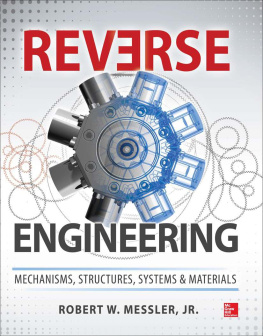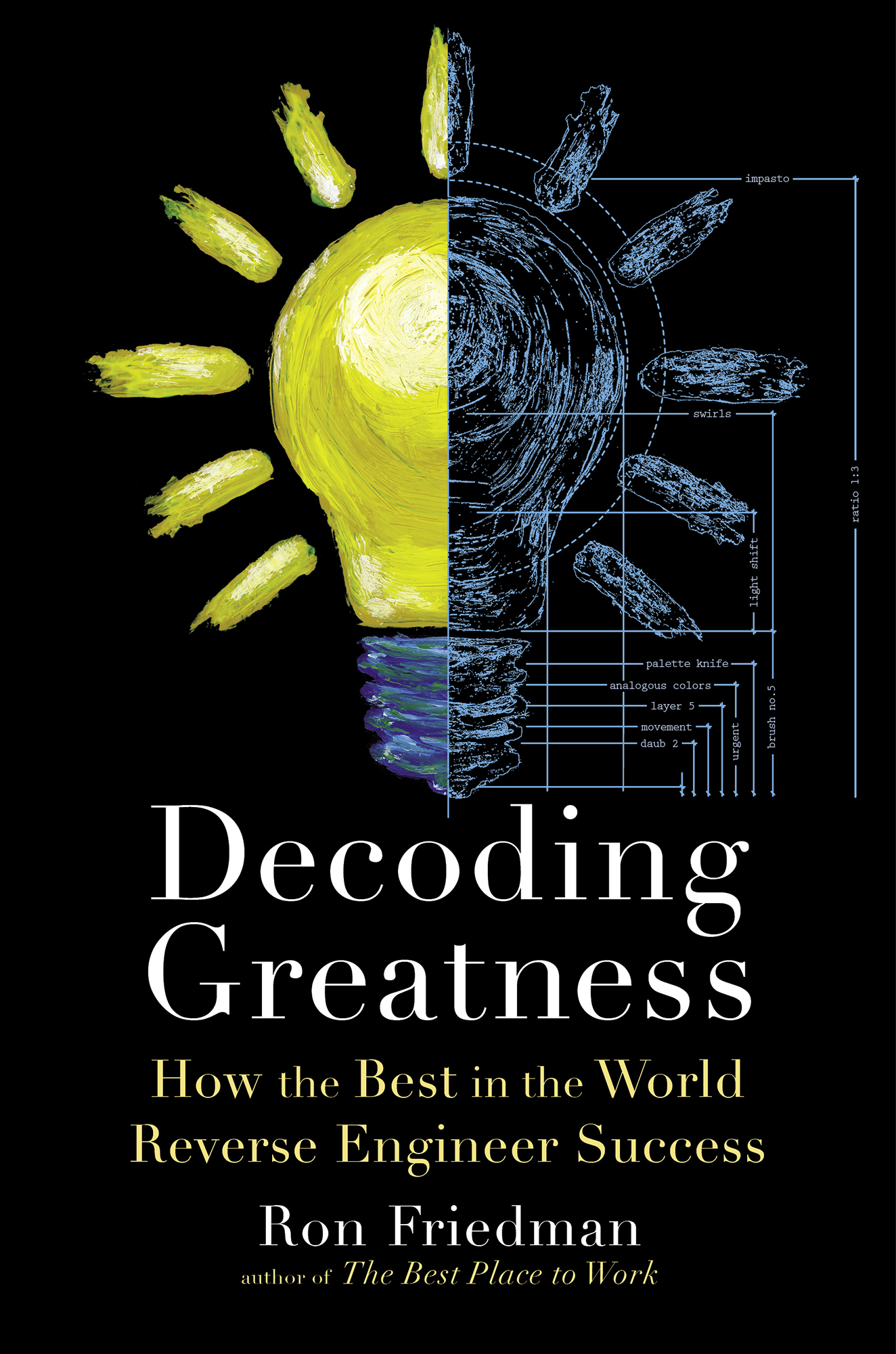Contents
Guide
Decoding Greatness
How the Best in the World Reverse Engineer Success
Ron Friedman author of The Best Place to Work
Also by Ron Friedman
The Best Place to Work:
The Art and Science
of Creating an
Extraordinary Workplace

Simon & Schuster
1230 Avenue of the Americas
New York, NY 10020
www.SimonandSchuster.com
Copyright 2021 by Ron Friedman
All rights reserved, including the right to reproduce this book or portions thereof in any form whatsoever. For information, address Simon & Schuster Subsidiary Rights Department, 1230 Avenue of the Americas, New York, NY 10020.
First Simon & Schuster hardcover edition June 2021
SIMON & SCHUSTER and colophon are registered trademarks of Simon & Schuster, Inc.
For information about special discounts for bulk purchases, please contact Simon & Schuster Special Sales at 1-866-506-1949 or .
The Simon & Schuster Speakers Bureau can bring authors to your live event. For more information or to book an event, contact the Simon & Schuster Speakers Bureau at 1-866-248-3049 or visit our website at www.simonspeakers.com.
Interior design by Lewelin Polanco
Jacket design and illustration by Jason Heuer
Library of Congress Cataloging-in-Publication Data is available.
ISBN 978-1-9821-3579-9
ISBN 978-1-9821-3581-2 (ebook)
For my grandmother,
who taught me the importance of
taking risks, holding loved ones by the hand,
and injecting lemon and dill into
(nearly) every dish
Introduction A Secret History from the Land of Innovation
B y the time Steve Jobs finds out hes been betrayed, it is already far too late. The press conference is over, and the news is out. Slowly it dawns on him: Apples head start is about to disappear.
The year is 1983, and we are in Cupertino, California. The computer company Jobs cofounded is barely seven years old. Its rise has been meteoric. In a few years, Wall Street will assess its value at more than a billion dollars. But now, just six short weeks from the release of Apples boldest innovation yet, the Macintosh, Jobs discovers hes been scooped.
The blow arrives from more than twenty-five hundred miles away, in the lavish ballroom of New York Citys famed Helmsley Palace Hotel. Onstage, standing before a gaggle of reporters, Bill Gates has just announced Microsofts plans to develop a user-friendly operating systemone with more than a few striking similarities to the Macintosh.
Back then, computers looked nothing like todays intuitive devices. Forget the colorful graphics, clickable icons, and interactive menus. If you wanted a 1983 computer to do anything, you had to reach for a keyboard and input a rigid, text-based language to convey your instructions.
Apples Macintosh featured two key innovations: dazzling on-screen visuals and the arrival of a mouse. No longer would users be forced to grapple with arcane computer language. On the new Mac, they could simply point and click.
Jobs couldnt wait to bring the Macintosh to market. His vision: in less than two months, his company would fundamentally disrupt the world of personal computing forever. But now here was Gates announcing the creation of this new operating systemsomething called Windows?
Jobs was livid. After all, Gates wasnt a competitorhe was a vendor.
It was almost too baffling to comprehend. Jobs had personally handpicked Microsoft to develop software for Apples computers. Hed been good to Gates. He had traveled with him to conferences, invited him onstage at Apple events, treated him as a member of his inner circle. And this was how he was being repaid?
Get Bill Gates down here, he demanded of his Microsoft handler. Tomorrow!
It didnt matter that Gates was at the other end of the country. Jobs got his wish.
The following day, Apples boardroom filled with its top brass. Jobs wanted bodiesa show of force when Microsofts team arrived. A showdown was about to take place, and he wasnt about to be outnumbered.
He need not have bothered. To everyones surprise, Microsoft didnt send a team. Gates arrived alone, ambling awkwardly in to face the firing squad.
Jobs wasted little time tearing into him. Youre ripping us off! he yelled, his underlings glaring, all eyes on Gates. I trusted you, and now youre stealing from us!
Gates took it in quietly. He paused a moment, not once looking away. Then he casually delivered a devastating line, rendering the entire room speechless: Well, Steve, I think theres more than one way of looking at it. I think its more like we both had this rich neighbor named Xerox, and I broke into his house to steal the TV set and found out that you had already stolen it.
Gates appreciated that Windows had not originally been his idea. What he wasnt prepared to stand for was this notion that a mouse-driven, graphics-based operating system was the creative brainchild of Steve Jobs. It didnt matter what heroic tales Apple was peddling to the press. Gates knew the truth. The Macintosh had never been Apples invention. It had been reverse engineered from a Rochester, New York, copier company named Xerox.
Back in the 1970s, while Steve Jobs was still in high school, Xerox faced an existential crisis. Its executives believed a paperless office was inevitable and they werent about to wait passively for its arrival. To kick start innovation, they founded the Palo Alto Research Center, in California, calling it Xerox PARC for short. It quickly emerged as an idea powerhouse, thanks to a rare combination of generous funding, a risk-embracing culture, and geographic serendipity. Silicon Valley was brimming with brilliant engineers and Xerox PARC arrived at just the right moment to pluck them up and grant them free rein.
Among Xerox PARCs countless inventions was a personal computer most people have never heard of: the Alto. It offered many of the same features that would come to distinguish the Macintosh, like graphics that made computers easier to use and a mouse for communicating commands. Except the Alto was developed a full decade earlier.
Xerox knew the Alto had valueit just didnt realize how much. It viewed the Alto as a niche product, a high-end office gadget that might be of interest to prestigious universities and major corporations. And no wonder. With a price tag of well over $100,000 (in todays dollars) and a minimum purchase requirement of five units, Xeroxs Alto was well outside the budget of even the wealthiest of Americans.
Xerox had a blind spot. Its executives, many of whom had come of age in the 1940s and 50s, considered typing the domain of secretaries. They simply could not conceive of a world in which computers were a household item. Which may explain why they were so cavalier about granting demonstrations of the Alto to many visitors, including one in 1979 to Steve Jobs.
Jobs was instantly captivated. Youre sitting on a gold mine, he told the Xerox engineer tasked with showing him the Alto. As the presentation went on, Jobs could barely sit still. He grew increasingly animated, visibly struggling to contain his excitement. At one point he blurted out, I cant believe Xerox is not taking advantage of this.
Afterward, he jumped into his car and sped back to the office. Unlike those plodding Xerox executives, he fully recognized the significance of this invention. Jobs believed hed been offered a glimpse of the future, and he wasnt about to wait until Xerox figured it out. This is it! he told his team. Weve got to do it!













